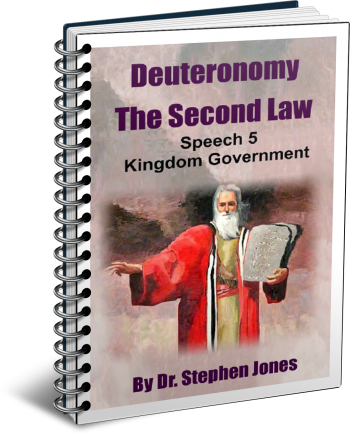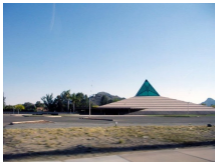Latest Posts
View the latest posts in an easy-to-read list format, with filtering options.

A commentary on the fifth speech of Moses in Deuteronomy 16-21. The book of Deuteronomy is a series of 12 speeches that Moses gave just before his death at the end of Israel's wilderness journey.
Category - Bible Commentaries

In Deut. 16:21, 22 God bans false worship from the Kingdom:
21 You shall not plant for yourself an Asherah of any kind of tree beside the altar of the Lord your God, which you shall make for yourself. 22 Neither shall you set up for yourself a sacred pillar which the Lord your God hates.
The term Asherah is translated in the KJV “groves.” Planting groves was common among the Canaanites who worshiped Baal, because they were meant to honor Astarte, the consort of Baal. Thus God banned such religious practice from Israel.
However, in later years the Israelites largely adopted the practice of the Canaanites and built groves in every sacred place around their altars. This is one of the main reasons that God cast Israel out of the land. We read in 2 Kings 17:10-12,
10 And they set for themselves sacred pillars and Asherim [plural of Asherah] on every high hill and under every green tree, 11 and there they burned incense on all the high places as the nations did which the Lord had carried away to exile before them; and they did evil things provoking the Lord. 12 And they served idols, concerning which the Lord had said to them, “You shall not do this thing.”
The result is seen in verse 18,
18 So the Lord was very angry with Israel, and removed them from His sight; none was left except the tribe of Judah.
Even Judah followed the same practices for most of their history, beginning with Solomon (2 Kings 23:13). There were, however, a few reformers like King Josiah, who turned the temple from a center of Baal worship back to being a temple of God (2 Kings 23). Yet by that time it was too late to avert divine judgment.
We know from Genesis 1 and 2 that God was the Creator of all trees and groves of trees and that He pronounced them “good.” The question is why did God ban all trees near His altar? Was there something inherently evil about trees that made God object to such a practice? Obviously not. Even Abraham himself planted a “grove” (KJV) when he built an altar at Beersheba. The NASB of Genesis 21:33 and 34 says,
33 And Abraham planted a tamarisk tree [eshel] at Beer-sheba, and there he called on the name of the Lord, the Everlasting God. 34 And Abraham sojourned in the land of the Philistines for many days.
The Hebrew word used here is not asherah, but eshel. Nonetheless, there is no doubt that Abraham planted a specific tree near that altar, a practice which Moses later banned. The important factor is that if Israel adopted the customs of the Canaanites in the worship, it would not be long before they would accept its religious meaning as well.
During the time of Abraham, Baal worship was not so widespread. His grove was planted in the land of the Philistines, who worshiped Dagon, the Fish God. A few centuries later, however, when Israel conquered Canaan, Baal worship was widespread in the land, so God instructed the people not to plant any tree in the vicinity of their altars of worship. Neither were they to set up any pillars. In dry places, where trees could not grow, pillars (or poles) served as substitutes for trees.
While pillars were banned under Moses, Jacob thought nothing of setting up a pillar at an altar at Bethel. Genesis 35:14 and 15 says,
14 And Jacob set up a pillar in the place where He had spoken with him, a pillar of stone, and he poured out a libation on it; he also poured oil on it. 15 So Jacob named the place where God had spoken with him, Bethel.
The word for “pillar” here is matstsebah. It is the same word that Moses used in Deut. 16:22 when banning pillars from being set up near their altars. We see then that pillars themselves are neither good nor evil, but men’s use of them, especially in worship, will determine whether it is a sin or not.
So let us look deeper into the Canaanite worship and its origin. According to Halley’s Bible Handbook, page 156,
“Baal was their principal god; Ashtoreth, Baal’s wife, their principal goddess. She was the personification of the reproductive principle in nature. Ishtar was her Babylonian name; Astarte her Greek and Roman name …. Temples of Baal and Ashtoreth were usually together. Priestesses were temple prostitutes. Sodomites were male temple prostitutes [homosexuals]. The worship of Baal, Ashtoreth, and other Canaanite gods consisted in the most extravagant orgies; their temples were centers of vice.”
Where did the Canaanites (and others) get the idea that worship ought to center around sexuality? Its origins go back to their interpretation of the fall of man in the Garden of Eden. They believed that Adam and Eve fell through sexual relations, either with the “serpent” or with each other. Their theology was also based on astrology, which includes a study of the seven visible planets—which in those days included the sun and the moon.
They believed that man fell from the heavens in seven successive stages, each being represented by a different planet. The final stage was the moon, which they took as a sexual symbol. Hence their religion taught that when Adam and Eve reached that final sexual stage—the moon—their fall or descent from heaven was complete.
Their way of salvation—that is, the path back to the heavens—was believed to be the same path in reverse that Adam and Eve took in their descent. In other words, they were required to return in the same path that they had fallen, beginning with the “moon.” The temples of Baal provided the people with that first step in their ascent back to heaven. They could come to the groves and have sexual relations with the representatives of their god (priests and priestesses) and thus begin to “purify” themselves in their journey back to the stars.
 This seven-step program was also represented by the Tower of Babel, constructed as a seven-stepped pyramid with a temple at the top made of green glass, from which the people would spring into the heavens. This tower became the model for the Capstone Cathedral, built by Neil Frisby in Arizona. It was topped by a pyramid made of green-blue glass on the top. He taught that when the “rapture” was near, God would tell him, so he could inform his followers. They would then gather at his mini-Tower of Babel to spring into the heavens.
This seven-step program was also represented by the Tower of Babel, constructed as a seven-stepped pyramid with a temple at the top made of green glass, from which the people would spring into the heavens. This tower became the model for the Capstone Cathedral, built by Neil Frisby in Arizona. It was topped by a pyramid made of green-blue glass on the top. He taught that when the “rapture” was near, God would tell him, so he could inform his followers. They would then gather at his mini-Tower of Babel to spring into the heavens.
Another form of this is found in the Mormon temples, which contain representations of the Garden of Eden in a room behind their altars. Their young people are “purified” or “blessed” in a ceremony that is a cleaned-up version of Canaanite theology. Much of this aspect of their theology was probably adopted from Freemasonry through the influence of Brigham Young, who turned Mormonism into a branch of Freemasonry in the 1830’s. Scottish Rite Freemasonry prides itself on being the successors of the Egyptian Mystery Religion that was not so different from the Canaanite worship of Baal.
The Canaanite and Babylonian interpretation of the story in Genesis 3 sexualized the fall of man and then provided their “solution” to the problem. They built temples and groves to recall the Garden of Eden. Yet their man-made solution only perpetuated the carnality and vice in mankind and did nothing to purify the people or to conform them to the image of Christ.
This is the religious belief system that God banned in order to keep the Israelites from falling into the same carnal vices found among the Canaanites. The ban on groves and pillars as objects of worship at altars or in temples was God’s way of repudiating their theological interpretation of Genesis 3. That, of course, is a topic in itself, and to do justice to it would require more space than we have in this present setting.
Some have used this ban on trees to speak against Christmas trees in church near the altars. They have identified this practice with that of the Canaanites. Yet once again, the spirit of the law—God’s intent—has to do with worship. If men worship Christmas trees, then it is an obvious sin. Most people consider their Christmas trees to be symbols of new life and apply this to the birth of the Messiah. Still others just like to decorate the house or church to bring an atmosphere of joy. God knows the intent of every man’s heart.
In Abraham’s day there was nothing wrong with planting a grove (or tree) near an altar of worship. It meant something to Abraham that was entirely different in later centuries when the Israelites were imitating the Canaanites and adopting many of their religious practices. Religious symbolism, then, is whatever men interpret it to be. Just because pagan practice and false religion use certain symbols to mean evil things does not mean that the Scriptures agree with their interpretations.
There are many symbols in the world, and each religion attaches its own meaning to them. Because of the complexity of symbolism, it is best to leave most such matters to the conscience of each person. If we study the Scriptures and learn the mind of Christ, we will then be equipped to be guided by the Holy Spirit. Christians in some countries will find it necessary to ban certain symbols, which present no problem in other countries.
The main concern, perhaps, is that Christians remain distinct. They should be careful not to adopt the practices of other religions in an attempt to blend in or minimize the distinction between Christ and other “saviors.” Israel’s example serves to show that the carnal tendency of man is to fall away from the true God and adopt other religions. Hence, there is no shortage of false understanding of God in the world, and man continually finds such beliefs and practices to resonate with his carnal mind.
True Christianity is always at a disadvantage in that way. Our advantage is the power of the Holy Spirit manifesting in our hearts and lives, but when we lose or reject the Holy Spirit, it is inevitable that we will begin to look to other religions for new life. God told Israel not to plant groves or build pillars near their altars, because He knew that if their altars resembled those of the Baal worshippers, the Israelites might soon lose sight of the distinction between Yahweh and Baal. They might then start to imitate other practices and doctrines of Baal and Ashtoreth. The end of that path is total degradation and the empowerment of the carnal mind of man in religion.